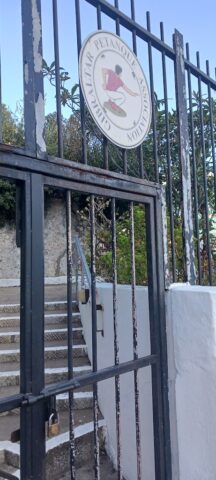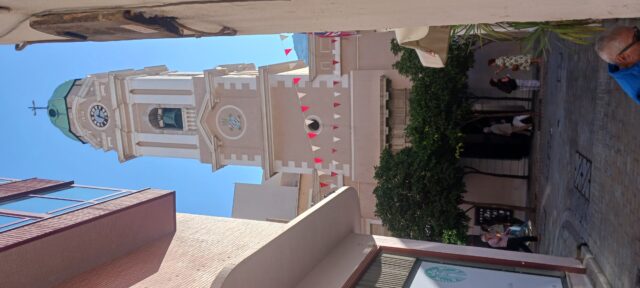Richard’s rendezvous It too, was an institution
Many of us may tend to think of important buildings and large organisations or corporate companies as institutions and not think of other entities that may also classify.
Yes a government building, like our Parliament building, the City Hall, our churches, the Gibraltar University, the hospital, the Garrison Library, John Mackintosh and quite a few others may instantly come to mind, but there are other places and organisations and groupings that may also qualify: charities, NGOs, even families and individuals can become institutions.
Put another way, long established customs that are accepted as part of our identity or culture.
Our social norms as a way of doing things can be included in a variety of definitions of the term ‘institution’.
But I have chosen to talk about - wait for it - shops and stores in particular, namely, retail institutions.
They were retail outlets that have had a significant established presence in our community – some of today’s High Street shops and stores and elsewhere qualify for that term too.
But I want to go back to the 50s and 60s.
We still hear older folk mention shops like, Teo, Pitto, Tady, La tienda de Flower en Bell Lane, Liptons of course, Raffo, the Golden Ham, Sanguinetti’s toy shop, Sacarello’s newsagents, Cazes and many more come to mind no doubt, and I’m going to go back to one that was perhaps, for many, less well known or frequented but popular none-the-less.
Fleming’s, La Tienda de jeans a lao del Gobernador. Situated where the smart, bright cafeteria and cake shop now occupies the space – Amar, opposite the King’s Chapel and below where I happen to live.
As I live in the same building, I used to pop in to chat to Ramu, and his older brother Manu, who ran the store for many years.
They took over from their dad who acquired Fleming’s, which traded as a military outfitters and tailor serving the very large numbers of sailors coming ashore from the ships of Britain’s mighty (in those days) Royal Navy.
Main Street was awash with naval seamen from Britain’s Mediterranean Fleet during those decades.
Dad Kisinchand Daswani managed the store from 1964 and because it was very popular, decided to keep the shop’s name. As time went on, and as the store had done very well under their dad’s management, the brothers decided to still keep Fleming’s as the name.
Perhaps a case of ‘if it’s not broken, why fix it’, and Fleming’s it was until the end.
Of course, they didn’t continue with the naval and military stuff and so moved on to watches and gifts, not unlike many Indian stores along Main Street.
However, somewhere along the line they came across the famous Wrangler jeans brand and the whole thing took off in a big way.
They were given a tip that, if they imported the jeans en masse, they would sell hundreds if not thousands across the Straits in Morocco.
Meanwhile the local population too, had already latched on to the fact that Fleming’s was the place to go for the super popular Wrangler jeans but before that, it will be recalled by many, Russian and other Eastern European whaling fleets and other merchant ships frequented the Rock regularly around 1967/68.
The crews took the Wrangler garments in their hundreds, not just jeans but jackets, coats, even plastic raincoats and shoes. Lots of winter clothing.
Fleming’s was on a roll. They even stocked rugs and Italian bedspreads which the Eastern Europeans used to also buy.
The shop was extremely busy all day long. Half the crews would come in the morning and the rest in the afternoon after work, with each crew member spending about 20 or 30 pounds each – a neat amount in those days.
Meanwhile local men and Spaniards, from not just the surrounding area but from further afield also, popped in regularly to buy their favourite jeans. Many would take two or three pairs.
Cheaper port facilities were being offered elsewhere, so the Russian fleets began to move further south to the Canary Islands. Shortly after that, the frontier closed and Fleming’s business also looked south to Morocco and their inhabitants who started coming to work on the Rock and the Spanish workers were removed.
Our new Moroccan workforce started to buy the jeans in large amounts too, in twenties and thirties and sent them over to their homeland where they were very much in demand.
Meanwhile, in 1985, when the frontier fully re-opened, business took a turn once again, and Spaniards from across the frontier began to cross over for shopping.
A pair of Wranglers in Spain would cost about £40 or £45 whilst here, at Fleming’s, £30. Local customers, and many others from different countries visiting the Rock, would seek the shop out and purchase the famous jeans at Fleming’s.
During all this time, it was the much sought after garment that was the pull towards the store because, physically, the shop was in a serious need of refurbishment or smartening up: at the very least, a good overhaul or tidying up.
There were stacks of jeans and other denim garments piled up all over the store. But yes, despite its shabby, untidy state, Fleming’s was certainly one of Gibraltar’s institutions.
But now it’s time to observe.
Sorry if I sometimes come across as a bit ‘pesao’ on some subjects, but the other side of the coin is, why can’t these very useful mechanical means be permanently fixed and have them run smoothly and not have them out of order so often? The Commonwealth Park lift keeps on breaking down and, at St Bernard’s Hospital, we seem to have a situation where the escalators seem to take it in turns to be working. First the going up one is working and the going down one is not and then it’s the other way around. Why, oh why do we have this problem continuously with our lifts and escalators?
We hear so much about our sports men and women doing so very well and deservedly so. In the meantime, the lesser but no less important sport (or is it just a hobby) of petanque, gets little publicity. They have a lovely club premises on Line Wall Road just before you get to the iron bridge, with a smart clubhouse and neat playing ground and red benches. Splendid.


And speaking of broken things, when will the Cathedral clock start working again, giving us the correct time, seeing as works on the roof have begun.
But my watch is on time, thank goodness, and it’s telling me it’s time to move on.
See you!









